The visibility, scale and scope of Russian military exercises have been a focus of Western media and specialist literature since 2014. Russia conducted VOSTOK 2018, the latest iteration of its annual strategic exercises, from early July to 17 September 2018. VOSTOK (meaning ‘East’) is part of a system of strategic exercises that the Russian Armed Forces have been developing since 2009. It is one of the four named annual strategic exercises conducted on a rotating basis among four of Russia’s five military districts1. These visible events represent a small fraction of what is a whole-of-government and nationwide Russian effort to develop the ability to conduct large-scale conflict on short notice against a major military power and to influence potential adversaries. To better understand and more accurately assess their implications for NATO Allies, VOSTOK 2018 and all of Russia’s strategic exercises, including large-scale snap exercises, need to be seen in their full context.
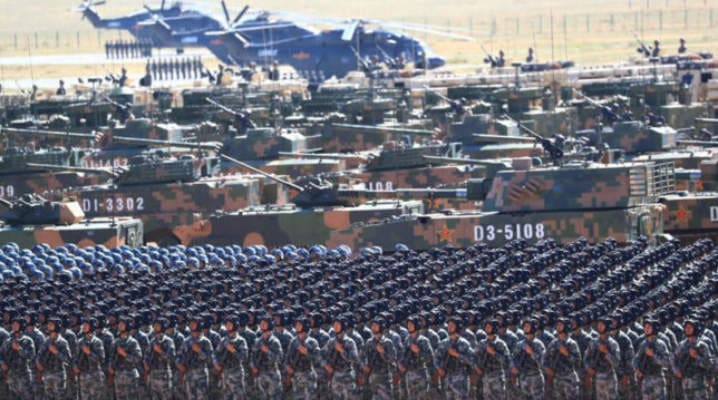
The show of force on 13 September, day three of the “active phase” of VOSTOK 2018 which included live-fire exercises, was more a carefully orchestrated military demonstration than a real military exercise. © News X
The strategic context
Russia’s chief foreign and defence policy aims are; to reassert a leading role for itself on the world scene; to disrupt the current European security architecture to force negotiation of a new one; and to rebuild a security perimeter against perceived external threats (primarily the United States and its NATO Allies). To these ends, Russia has launched a strategic destabilisation campaign against the post-Cold War liberal order, which President Putin views as counter to Russia’s long-term interests. Military exercises and operations are part of that campaign. This multidimensional campaign is the proper context within which to consider Russia’s strategic exercises and illuminates their instrumentality for achieving its foreign, security and defence policy aims – and the related implications for the security of NATO Allies.
Russia’s first use of military force to revise the Euro-Atlantic security environment came in August 2008 in its short war against Georgia. The conflict exposed significant capability shortfalls in the Russian Armed Forces and sparked the military overhaul that continues to this day. This overhaul reflects Moscow’s evolving strategic worldview in line with the Russian perception that conflict can break out with little or no warning in multiple strategic directions. It is underpinned by the Russian leadership’s interpretation of the ‘Colour Revolutions’ of the 1990s and early 2000s as, from Moscow’s perspective, a non-kinetic form of destabilisation operation waged by Western powers.
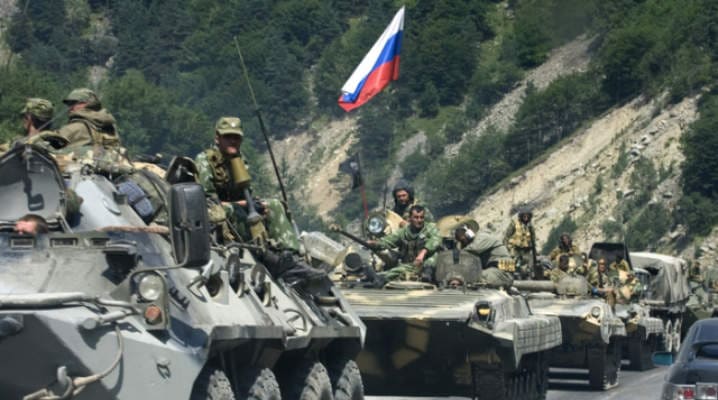
Russia’s short war against Georgia in August 2008 exposed significant capability shortfalls in the Russian Armed Forces and sparked the military overhaul that continues to this day. © Georgia Today
The comprehensive military reform and modernisation efforts launched after the war with Georgia, including the exercise programme, have transformed the Russian Armed Forces into an effective tool in Russia’s destabilisation campaign against the West, with major implications for Euro-Atlantic security. The capabilities developed enabled Russia’s aggressive actions against Ukraine in 2014 and its rapid intervention in Syria in 2015. Russia’s revived military power is a central element of the destabilisation campaign that it has been conducting in the Euro-Atlantic area for the last ten years. At their 2018 Summit in Brussels, Allied leaders declared that Russia’s aggressive actions, including the threat and use of force to attain political goals, challenge the Alliance and are undermining Euro-Atlantic security and the rules-based international order.
Exercising for strategic operations
The scheduled strategic exercises (ZAPAD, VOSTOK, TSENTR, KAVKAZ) are the capstone event of the Russian Armed Forces’ annual training cycle. During the several weeks of their actual duration, the exercises fulfil the General Staff’s presidentially mandated task to organise and test the transition of the Russian Federation from peace to war. After completing the transition, they test national preparedness for large-scale, high-intensity warfare against a technologically advanced peer adversary.
Any assessment of Russian strategic exercises should also take into account the large-scale snap (no-notice) exercises2 that President Putin reinstituted in 2013 of which four to six are conducted annually at various levels – including military district, fleet, or service or branch – and encompassing units from across most of the Armed Forces in the course of a year.
The scheduled and snap strategic exercises are conducted under the direction of the Minister of Defence and the operational control of the General Staff through the National Centre for the Direction of Defence. Command and control is a key aspect, testing the effectiveness and readiness of command echelons from the national level down to the brigade level. On this basis, the General Staff has the ability to conduct a strategic command post exercise that depicts national mobilisation and conflict escalation up to and including general war, regardless of the apparent scale and duration of the field training segment of the annual strategic exercise.
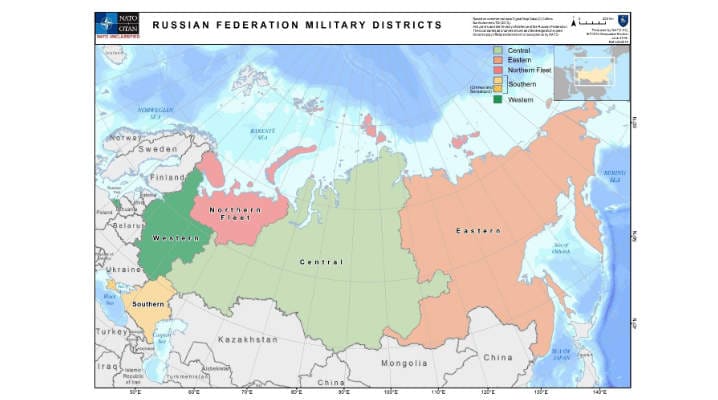
Russia’s programme of annual strategic exercises rotates the lead role among four of Russia's five military districts, while retaining a force- and nation-wide character. © NATO
This overall context makes clear that Russia’s strategic exercises are oriented to multidirectional, theatre-level conflict and their capability- and capacity-building effects are strategic. It is useful to think of this exercise programme as a kind of military ‘circuit training’ – exercising different muscle groups on a rotating basis to strengthen the entire organism for the main event. Likewise, the command and control element are like the training of the mind that winning athletes undertake. Similarly, the capabilities built during the strategic exercises are generically applicable to potential future large-scale conflicts. With this as the model for the strategic exercises, even one as distant from NATO’s borders as VOSTOK 2018 has, by design, implications for Allied security.
The show of force and the actual exercise
VOSTOK 2018 was, in effect, two events. The first – and militarily more significant – took place at multiple locations from early July until September. The second was a scripted show of force, on 13 September, at the Tsugol training range in the Trans-Baykal Region.
In line with standard Russian practice, the show of force was designed to send ambiguous and contradictory messages: images of growing military strength on the one hand and rhetoric of non-aggression and transparency on the other. For this event, Russia’s senior military leaders drew the desired level of foreign attention to VOSTOK 2018 by stating publicly that approximately 300,000 troops – as well as 1,000 fixed-wing aircraft and helicopters, 80 ships, and 36,000 tanks, armoured and other vehicles – would participate in an exercise unprecedented in scale since the Soviet-era ZAPAD 1981.
This show of force on day three of the “active phase” of VOSTOK 2018 included live-fire exercises carried out under the observation of President Putin and the Chinese Minister of Defence. The participating Russian, Chinese and Mongolian forces conducted a massive parade of military vehicles to close the day’s events. Despite the hype, the 13 September activities were more a carefully orchestrated military demonstration than a real military exercise. It was staged for media cameras as a backdrop befitting President Putin’s strongman image and his message of military strength to domestic and foreign observers. Nevertheless, one should not overlook the training value – from a logistics and combat service support perspective – of the movement of substantial forces and equipment to the Tsugol range and their sustainment in the field.3
The militarily more significant part of the VOSTOK exercise comprised two phases. The first, from July to early September, entailed weeks of logistics activities to move troops, equipment and supplies to their assembly and exercise areas. The second, “active phase”, from 11 to 17 September, encompassed the exercise activity and live-fire events at the Tsugol range and other land and maritime ranges in the Eastern Military District, and at other locations across Russia.
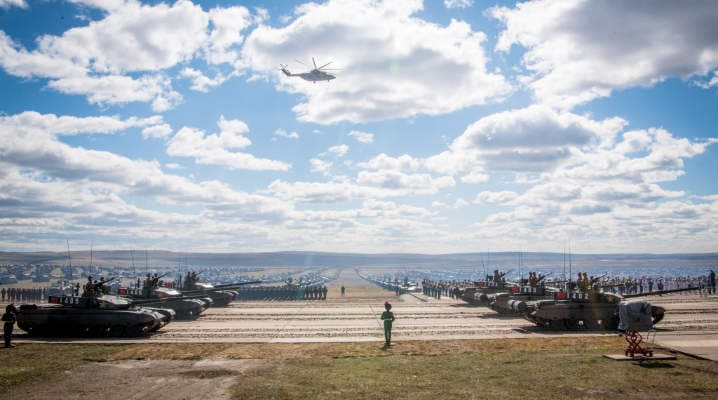
Russia's massive drills were two things at once: a military drill where troops tested their combat preparedness; and a diplomatic exercise highlighting relations with China, aimed at the West. © Chatham House
In preparation for VOSTOK, 16 special exercises of various support functions units were conducted in July and August. Also, snap exercises of the Northern Fleet were held in mid-August and of the Central and Eastern Military Districts at the end of August. Mobilisation of reserve forces was also exercised, with 21 units in ten subject territories of the Russian Federation4 mobilised and several thousand citizens recalled from the reserves. Units of the territorial guard of the Central and Southern Military Districts were formed up and transported to the Eastern Military District for exercises. Minister of Defence Shoygu said after the conclusion of VOSTOK that industrial mobilisation was also exercised.
The Ministry of Defence described the “active phase” of VOSTOK 2018 as taking place at five combined arms ranges in the Eastern Military District (Tsugol, Bamburovo, Radygino, Uspensky, Bikinsky) and four air force and air defence ranges (Litovko, Novoselskoye, Telemba, Bukhta Anna) and in the Bering Sea, Sea of Okhotsk and Sea of Japan. However, the Ministry also announced VOSTOK exercise activity at other locations, such as the Kapustin Yar missile range, during the event. According to the Ministry, this phase would include operations by two opposing sides, with the Central Military District and Northern Fleet forces playing the adversary role against Eastern Military District and Pacific Fleet Forces. If true, this would have marked another significant evolution in the complexity and training value of the strategic exercises.
A number of dual-capable (conventional/nuclear) weapons systems participated in the exercises, conducting simulated or live-fire launches. This included TU-95MS (BEAR H) strategic bomber cruise missile launches over the Barents, East Siberian, Chukchi and North Arctic Seas and at the Telemba range; ISKANDER (SS-26 STONE) launches at the Kapustin Yar missile range; and MOSKIT (SS-N-22 SUNBURN) cruise missile launches by Pacific Fleet Forces against naval groupings of the notional adversary. Russian Ministry of Defence reporting did not specify whether these systems exercised their nuclear role, for example, whether the MOSKIT launch simulated the assigned navy mission “to inflict not less than critical damage on the enemy fleet by use of non-strategic nuclear weapons”. Aerospace forces exercised layered air and missile defence regionally and at exercise ranges.
How big was VOSTOK 2018?
The Russian military leadership consistently messaged that VOSTOK 2018 would be the largest Russian military exercise in decades. Western media picked up this refrain. However, informed observers soon expressed scepticism and a debate ensued over the size of the impending exercise and what comprised the much-touted 300,000 figure. This kept media attention focused on VOSTOK in the weeks leading up to the active phase, which was undoubtedly the Russian leadership’s intention.
Minister of Defence Shoygu described the basis for the 300,000 figure after the conclusion of the exercise. In a post-exercise interview on 17 September with the Russian Defence Ministry’s newspaper, Krasnaya Zvezda, Minister of Defence Shoygu described all the preparatory exercises and activities leading up to and including the active phase, stating that "in all this complex of events, more than 300,000 servicemen were involved. This was, actually, the Armed Forces, two military districts (Central and Eastern), two fleets (Pacific and North), aviation, army aviation and our fellow allies - the armed forces of China and Mongolia.”
In other words, the 300,000 troop figure was an approximate total of all personnel involved in every phase of preparation and execution of the VOSTOK 2018 from early July through to 17 September. The 300,000 figure may be plausible for this timeframe but leaves open the question of the number of participating combat troops. One historical study of the ratio of support to combat troops in modern war suggests, out of a total of 300,000 troops, a possible range of 75,000-100,000 combat troops might have participated at the various ranges during the active phase of VOSTOK 2018. However, this is a very rough estimate.
| Year | Exercise | Military District | MOD-Announced Participating Troops | Estimated Participating Troops |
|---|---|---|---|---|
| 2008 | KAVKAZ | North Caucasus (now Southern) | 8,000 | 40,000 |
| 2009 | ZAPAD | Western | 11,900 | 13,000 |
| 2010 | VOSTOK | Eastern | 20,000 | - |
| 2011 | TSENTR | Central | 12,000 | - |
| 2012 | KAVKAZ | Southern | 8,000 | - |
| 2013 | ZAPAD | Western | 11,920 | 90,000 |
| 2014 | VOSTOK | Eastern | 100,000 | 155,000 |
| 2015 | TSENTR | Central | 95,000 | 100,000 |
| 2016 | KAVKAZ | Southern | 12,500 | 120,000 |
| 2017 | ZAPAD | Western | 12,700 | 60,000-70,000 |
| 2018 | VOSTOK | Eastern | 297,000 | 75,000 - 100,0005 |
The lack of definitive numbers of troop levels at the various phases of VOSTOK 2018 illustrates the inevitable uncertainty created by Russia’s approach to its large-scale exercises, and to related transparency and confidence-building measures. It also fits the pattern of, on the one hand, systematic Russian under-reporting of troop figures for exercises west of the Urals, where treaty-based reporting and observation requirements apply (thereby avoiding formal observations); and, on the other hand, accurate or even over-reporting for exercises east of the Urals, where no reporting or observation requirements apply.
Russian military leaders asserted – with reference to the ad hoc measures they substitute for effective confidence- and security-building measures – that VOSTOK 2018 was the most transparently conducted exercise on record, which included briefings in the NATO-Russia Council and the Organization for Security and Co-operation in Europe, and invitations to hundreds of journalists and 89 foreign military attachés to observe at the Tsugol range. Despite this, the question of the exercise’s actual size remains unanswered. In light of this pattern, NATO needs to consider the possibility that Russia’s strategic exercises include the testing of large-scale maskirovka6 to obscure force movements, and the related operational implications.
Russian-Chinese military cooperation
VOSTOK 2018 also demonstrated a significant incremental step in Russian-Chinese military cooperation with both political and military implications. At the political level, Chinese media reported that the joint drills were intended to “consolidate and develop the China-Russia comprehensive strategic partnership”. For Russia’s part, Chinese participation was another visible demonstration that Russia is not isolated diplomatically or militarily regardless of tensions with the West. Despite strategic interests that may fundamentally diverge in the medium to long term, Russia and China, for now, want to present a common front to their perceived potential adversary, the United States, and VOSTOK provided an opportunity to do so.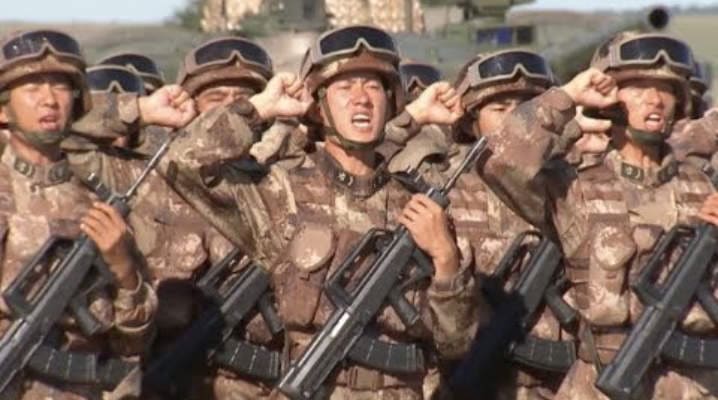
China sent approximately 3,000 troops, 900 tanks and military vehicles, and 30 fixed-wing aircraft and helicopters to participate in VOSTOK 2018. © YouTube CCTV Video News Agency
The military significance of the Chinese participation is not to be discounted either. China sent approximately 3,000 troops, 900 tanks and military vehicles, and 30 fixed-wing aircraft and helicopters from its 78th Army Corps to the Chita region via road, rail and air. This provided the first opportunity for People’s Liberation Army (PLA) units to participate in large-scale foreign drills after the 2016 reforms of PLA command structures. The staff, command and control, and logistical requirements for such a first-time effort, even at the brigade and squadron level, would have been considerable and would tangibly build capabilities for further military cooperation.
The Chinese participation in VOSTOK 2018 itself built upon experience gained in eight joint naval exercises conducted since 20127. As a point of comparison, NATO-Russia military cooperation by operational units never approached this scale or regularity, despite expressed aspirations toward the ability for joint decisions and joint action expressed in the framework of NATO-Russia cooperation since the signing of the Founding Act in 1997. In contrast, Russia and China are building multidimensional military and military-industrial cooperation.
Politico-military relevance to NATO
For all these reasons, the VOSTOK exercise is relevant to the security and stability of the Euro-Atlantic space, despite its geographic distance from NATO territory. Like all of Russia’s scheduled and snap strategic exercises, it is just one component of Russia’s ‘circuit training’ for large-scale war.
The capabilities developed and practiced during VOSTOK and the other exercises can be brought to bear on NATO’s flank as easily as they can be projected in any other strategic direction. Russia’s are by far the largest military exercises in Europe and are unique for their aims, size and frequency – as well as their lack of transparency. It is part of the ‘new normal’ for 70,000 to 150,000 troops to participate in Russia’s snap or planned strategic exercises. As Joseph Stalin is said to have observed, quantity has its own quality. What we see in the case of modern Russia is the ability to concentrate large forces relatively quickly anywhere on its periphery, under a nuclear shadow and with robust anti-access/area denial (A2/AD) capabilities aimed at preventing an adversary from occupying or traversing an area of land, sea or air.
The exercises create a twin challenge to predictability and stability on NATO’s eastern flank: the operational capabilities that exercises like VOSTOK build in Russia’s forces and, after the events of 2008 in Georgia and 2014 in Ukraine, the reasonable doubt as to the nature and intent of any major force movements.
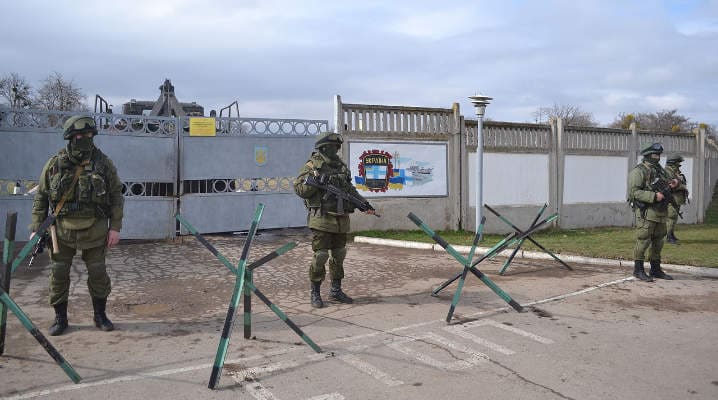
“Little green men” stand guard in front of the Sebastopol naval base after Russia’s illegal annexation of Crimea in March 2014.
VOSTOK and the other large-scale exercises also demonstrate and build the Russian Armed Forces’ capacity for sustained operations. Nearly five years on from the initiation of hostilities against Ukraine and three years after the start of operations in Syria, Russian military forces continue to operate in both theatres, while also continuing or initiating operations (such as air and maritime patrols) in other regions. Meanwhile, Russia is carrying on with its military modernisation, maintaining its programme of large-scale exercises, keeping military forces in a number of former Soviet republics –whether by bilateral agreement, without the countries’ consent, or illegal occupation – and expanding its presence well beyond its periphery. These developments suggest the need to reassess doubts about Russia’s ability to sustain military operations, including large-scale ones.
VOSTOK as a milestone and the road ahead
The completion of VOSTOK 2018 marked ten years of Russia’s annual strategic exercises. The year 2018 also marks five years since the reinitiation of large-scale snap exercises in the Russia military. This exercise programme has significantly improved the Russian Armed Forces’ warfighting and power-projection capabilities. These, in turn, support and enable Russia’s strategic destabilisation campaign against the West, with military force always casting a shadow of intimidation over Russia’s sub-kinetic aggression. This strategic context highlights NATO Allies’ motivations in committing both to meaningful dialogue with Russia and to strengthening NATO’s deterrence and defence posture.
At the 2018 NATO Summit in Brussels, Allied leaders stated that the Alliance continues to adapt in order to ensure that its deterrence and defence posture remains credible, coherent, resilient and adaptable to a changing security environment. This includes an effective response to changes in the posture and doctrine of potential adversaries, and their significant investments to modernise and expand capabilities. The Allies noted that it is of strategic importance to heighten readiness and improve reinforcement as well as to ensure the Alliance’s political and military responsiveness, including through more regular exercises. The implications of Russia’s strategic exercises, in their full context, demonstrate the criticality of continued progress on these and all other aspects of NATO’s ongoing adaptation.
1 The Military Districts are also designated as Joint Strategic Commands (JSCs). The Northern Fleet Military District/JSC was created in December 2014 but, as of 2018, has not been integrated into the rotation of the annual strategic exercises on its own. It has participated in snap exercises, exercised concurrently with the Western Military District ZAPAD 2017 exercise, and participated directly in VOSTOK 2018.
2 No notice means the participating forces and command echelons below the General Staff are unaware of the timing of the exercise. These large-scale exercises take place on an unscheduled basis in various of the Military Districts/Joint Strategic Commands, fleets, services and branches. As a side-effect, Russia also gives no advance notification of the exercises to the Organization of Security and Co-operation in Europe under Vienna Document requirements.
3 Logistics is the transfer of military personnel and materiel, Combat Service Support sustains personnel and material in the field and includes such functions as maintenance, transportation, supply, medical support, field services such as feeding and clothing, human resources, and religious support. See, for example, US Army Field Manual FM 3-0.
4 Subjects of the Russian Federation federal state include republics, territories, regions, cities of federal significance and autonomous regions.
5 An estimated 75,000-100,000 combat troops participated at the various ranges during the active phase of the exercise and 297,000 total troops (combat and support) during the preparatory and active phase from late June to 16 September 2018. However, this estimation is based on a study of US Army tooth-to-tail ratios from the First World War through to the second Iraq War and could vary widely from the actual numbers due to possible differences between US and Soviet/Russian approaches to logistics and combat support.
6 Military deception intended to deceive the adversary as to the composition, location, actions, and intentions of Russian forces.
7 Beginning in 2012 in the Yellow Sea and followed by: 2013, Sea of Japan; 2014, East China Sea; 2015, Black Sea/Mediterranean and August, Sea of Japan; 2016, South China Sea; 2017, Baltic Sea and September, Sea of Japan/Sea of Okhotsk.
This article is a summary of a forthcoming paper to be issued by the NATO Defense College.
